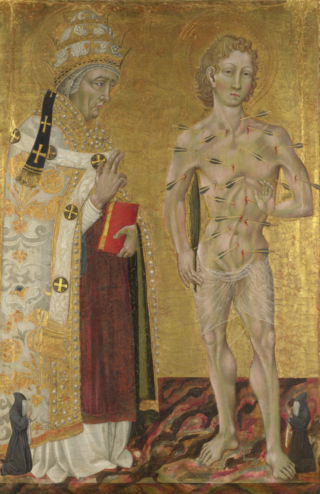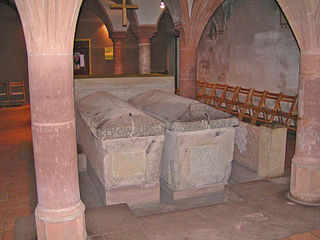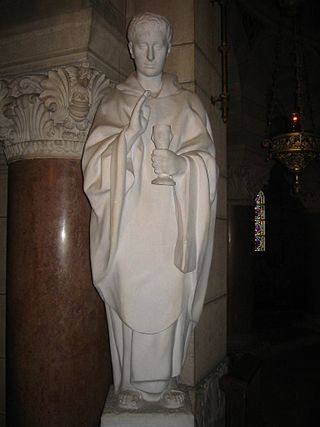
Agnes of Rome is a virgin martyr, venerated as a saint in the Catholic Church, Oriental Orthodox Church and the Eastern Orthodox Church, as well as the Anglican Communion and Lutheran Churches. She is one of several virgin martyrs commemorated by name in the Canon of the Mass, and one of many Christians martyred during the reign of the Roman emperor Diocletian.

Pope Fabian was the bishop of Rome from 10 January 236 until his death on 20 January 250, succeeding Anterus. A dove is said to have descended on his head to mark him as the Holy Spirit's unexpected choice to become the next pope. He was succeeded by Cornelius.

Gaius Sollius Modestus Apollinaris Sidonius, better known as Sidonius Apollinaris, was a poet, diplomat, and bishop. Born into the Gallo-Roman aristocracy, he was son-in-law to Emperor Avitus and was appointed Urban prefect of Rome by Emperor Anthemius in 468. In 469 he was appointed Bishop of Clermont and he led the defence of the city from Euric, King of the Visigoths, from 473 to 475. He retained his position as bishop after the city's conquest, until his death in the 480s. He is venerated as a saint in the Catholic church, the Orthodox Church, and the True Orthodox Church, with his feast day on 21 August.

Denis of France was a 3rd-century Christian martyr and saint. According to his hagiographies, he was bishop of Paris in the third century and, together with his companions Rusticus and Eleutherius, was martyred for his faith by decapitation. Some accounts placed this during Domitian's persecution and incorrectly identified St Denis of Paris with the Areopagite who was converted by Paul the Apostle and who served as the first bishop of Athens. Assuming Denis's historicity, it is now considered more likely that he suffered under the persecution of the emperor Decius shortly after AD 250.

Nectarius was the archbishop of Constantinople from AD 381 until his death, the successor to Saint Gregory Nazianzus and predecessor to St. John Chrysostom.

Martial, called "the Apostle of the Gauls" or "the Apostle of Aquitaine", was the first bishop of Limoges. Venerated as a Christian Saint, his feast day is 30 June.

According to Catholic Tradition, Trophimus of Arles was the first bishop of Arles, in today's southern France.

Stremonius or Saint Austremonius or Saint Stramonius or Austromoine, the "apostle of Auvergne," was the first Bishop of Clermont. He is venerated as a saint in the Catholic Church.

Radegund was a Thuringian princess and Frankish queen, who founded the Abbey of the Holy Cross at Poitiers. She is the patroness saint of several churches in France and England and of Jesus College, Cambridge.

Pancras was a Roman citizen who converted to Christianity and was beheaded for his faith at the age of fourteen, around the year 304. His name is Greek, meaning 'all-powerful'.

Saint-Nectaire is a commune in the Puy-de-Dôme department in Auvergne in central France. The village is in two sections Saint-Nectaire-le-Haut and Saint-Nectaire-le-Bas.

The Feast of Saints Peter and Paul or Solemnity of Saints Peter and Paul is a liturgical feast in honor of the martyrdom in Rome of the apostles Saint Peter and Saint Paul, which is observed on 29 June. The celebration is of ancient Christian origin, the date selected being the anniversary of either their death or the translation of their relics.

Saint Eucharius is venerated as the first bishop of Trier. He lived in the second half of the 3rd century.
Peregrine (Peregrinus) of Auxerre is venerated as the first bishop of Auxerre and the builder of its first cathedral. A strong local tradition states that he was a priest of Rome appointed by Pope Sixtus II to evangelize this area at the request of the Christians resident in that part of Gaul. He preached at Marseilles, Lyon, and converted most of the inhabitants of Auxerre to Christianity.

The Archdiocese of Clermont is a Latin archdiocese of the Roman Catholic Church in France. The diocese comprises the department of Puy-de-Dôme, in the Region of Auvergne. The Archbishop's seat is Clermont-Ferrand Cathedral. Throughout its history Clermont was the senior suffragan of the Archdiocese of Bourges. It became a metropolitan see itself, however, in 2002. The current archbishop is François Kalist.

Saints Ferreolus and Ferrutio are venerated as martyrs and saints by the Catholic Church, especially in Besançon where they are honored as its patron saints.
Nectarios, Nektarios or Nectarius is a Greek male given name encountered in Greece and Cyprus. It means "of nectar". Although its etymology refers to the word νέκταρ, the name Nectarios was never used in ancient Greece. It can be first seen no later than 300 AD as a Christian name, mainly of monks and bishops, in 20th century it became renowned in the Orthodox world by the lives of Saint Nectarios of Aegina and Venerable Nectarios of Optina.

Saint Hesychius is venerated as the patron saint of Cazorla, Spain.
Saint Nectarius of Autun was a 6th-century bishop of Autun, and a saint of the Roman Catholic Church.

Aurillac Abbey, otherwise the Abbey of Saint Gerald, Aurillac, founded around 895 in Auvergne by Count Gerald of Aurillac, destroyed during the French Wars of Religion and suppressed with the Revolution, was one of the oldest Benedictine abbeys, and probably influenced, in its arrangements and organization, the foundation of Cluny itself.



















